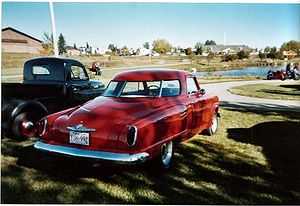Studebaker Starlight

The Starlight coupe was a unique 2-door body style offered by Studebaker Corporation of South Bend, Indiana (USA) from 1947 to 1952 in its Champion and Commander model series. The Starlight body style was considered a halo model and was designated 5P (presumably "five-passenger", to distinguish it from the three-passenger Businessman's coupe). It was also manufactured in Vernon, California.
Unlike other pillared two-door sedans that use two side windows separated from the rear window by roof supports, designer Robert E Bourke[1]:p.267 created a roof rounded at the rear with a wraparound window system that provided a panoramic effect, similar to a railroad observation car. The curved window was achieved with four fixed panels of glass. The roof was supported by two wide pillars (sometimes called "B" pillars) immediately behind the doors and in front of the wraparound back window. The body style was originally named, simply, "5-passenger coupe"; however, for the 1949 model year it was renamed Starlight Coupe.
Critics of the radically styled models commented by asking the rhetorical question, "Which way is it going?"[2] (Comedian Fred Allen quipped: "Next year Studebaker is coming out with a model that you won't be able to tell if it is going sideways".) However, the car's unique profile provided the Studebaker marque with an easily recognized model. While considered revolutionary, other U.S. automobile manufacturers failed to follow with other similarly styled cars and instead focused their attentions on developing pillarless hardtop models.
| Engine | Transmission | HP | Wheelbase | Length |
|---|---|---|---|---|
| 169.9 CID 1-bbl. 6-cylinder/226 CID 2-bbl. V-8 | 3-speed manual,[3] Overdrive, automatic | 102[3] | 119 in (3,023 mm) | 204.4 in (5,192 mm) |
For 1950 and 1951, all Studebakers received a freshening of the 1947 design with the addition of the "bullet nose" (or "spinner") front sheet metal; when combined with the Starlight body style, Studebakers looked comparatively futuristic at the time. This version of the Starlight body style continued until the end of the 1952 model year when it was sold side by side with a hardtop ("Starliner") version of the same models.
In 1953 Studebaker radically redesigned all of its models and discontinued the 1947–1952 panoramic "5-passenger" ("Starlight") coupe. Studebaker sedans rode on an 116 in (2,900 mm) wheelbase, although emphasis was placed on the sports car-like "Loewy" 2-door coupes that rode on Studebaker's longer 120 in (3,000 mm) wheelbase. Offered in both Champion and Commander model ranges, the coupes were available as pillared and hardtop body styles. Hardtop coupes were designated Starliners while the Starlight designation was applied to the five window pillared coupes. The styling on both these later cars influenced the Hillman Minx of the late 1950s and 1960s, which was also designed by Raymond Loewy.
The 1955 model name of the previous Starlight reverted to "5-passenger coupe", "Starliner" became "5-passenger hardtop."
For 1956, these coupes were heavily modified and reissued as the Studebaker Hawk series.
In 1958, Studebaker again applied the Starlight name to a body style, this time on its first full-sized hardtop models since 1952. With lackluster sales and a switch to the compact Lark, the company no longer was in need of the Starlight moniker and it was permanently retired at the end of the model year.
Oldsmobile would attempt an effect similar to the Starlight in 1977 with its Toronado XS model. Unlike the Studebaker, however, advances in auto glass production allowed the Toronado wrap around window to be manufactured in one sheet of glass that was bent using "hot wire" technology.
In popular culture
The King Crimson song "Neal and Jack and Me" from their 1982 album "Beat" frequently references a 1952 Studebaker Starlight Coupe. This song was inspired by Beat writers. The 'Jack' of the title is Beat writer Jack Kerouac, while 'Neal' is Kerouac's best friend Neal Cassady.
Footnotes
- ↑ Bourke, Robert E. The Starlight and the Starliner: Some recollections of a designer. New Albany: Automobile Quarterly. pp. 266–273. Vol X, 3rd Q, 1972.
- ↑ Langworth (below), pp. 22-40
- ↑ 3.0 3.1 Flory, Jr., J. "Kelly" (2008). American Cars, 1946-1959 Every Model Every Year. McFarland & Company, Inc., Publishers. ISBN 978-0-7864-3229-5.
References
- Maloney, James H. (1994). Studebaker Cars. Crestline Books. ISBN 0-87938-884-6.
- Langworth, Richard (1979). Studebaker, the Postwar Years. Motorbooks International. ISBN 0-87938-058-6.
- Gunnell, John, Editor (1987). The Standard Catalog of American Cars 1946-1975. Kraus Publications. ISBN 0-87341-096-3.
| ||||||||||||||||||||||||||||||